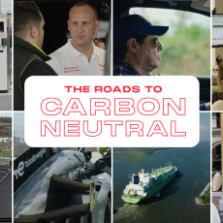The Roads to Carbon Neutral - Season 5 - Episode 4 - Powering the Big Apple
The Roads to Carbon Neutral - Season 5 - Episode 4
Powering the Big Apple
The Roads to Carbon Neutral
The fifth season of our program entitled “The Roads to Carbon Neutral”, in partnership with CNBC Catalyst, provides an insight into the solutions and innovations making the transition to low-carbon energy a reality and helping us achieve a carbon-neutral future. These powerful on-the-ground stories are led by TotalEnergies’ employees.
In this episode, we explore New York State’s largest onsite solar generating and storage system at John F. Kennedy (JFK) International Airport. Alex Sarly, Development Director, introduces us to this innovative solar carport canopy. Resulting from a strategic partnership between TotalEnergies, the Port Authority of New York and New Jersey (PANYNJ), and the New York Power Authority (NYPA), this historic project represents a milestone in the transition towards a more sustainable future.
Alex Sarly, Development Director, TotalEnergies: In tennis, I often encounter flow. It's an interplay between performance and strategy, where every single action counts. And just like in tennis, at work, my actions are very deliberate. It also requires precision, determination and teamwork. When I wake up in the morning, the first thing I do is I get sunshine on my face. So it's kind of funny that I work in an industry that also uses the sun to energize. I work for TotalEnergies, a multi energy company, producing primarily hydrocarbons, with a growing focus on renewable projects like this one at JFK. It's very important that projects like these get built in cities like New York. This solar project at the iconic JFK airport has been one of our biggest undertakings. I feel we're building a blueprint for a more sustainable future. Coming back to New York City, always brings up lots of happy memories. I actually met my wife here and we started our family here together. In a place like New York City, every inch of space counts. It's very difficult to find open areas. This is the challenge for the Port Authority of New York and New Jersey and the New York Power Authority when looking for ways to meet their decarbonization goals. They realized that utilizing the existing built environment could be a solution. JFK’s long term parking lot nine has one of the largest parking lots in all of New York State, making it an ideal location to put this into practice. JFK was once the gateway to the West, and now it's undergoing about a $20 billion revitalization program, really making it a world class facility again. These solar parking canopies and battery energy storage system will reduce greenhouse gas emissions at the airport by approximately 6,000 metric tons per year. We broke ground on this project 12 months ago. I was involved in overseeing all the planning well before that. We're currently halfway through the project and we're due to install battery storage containers later this month.
Scott Kessler, Program Director, Office of Sustainability, PANYNJ: So this is the biggest individual project we actually have contributed to our goals. We're aiming to get to 50% decarbonization by 2030, full net zero by 2050. It is sort of the central piece to us becoming a leader in airport sustainability.
Benjamin Cuozzo, Director / DER Advisory, New York Power Authority: It’s the largest canopy project within not only New York City, but in New York State and is the largest single solar project within the five boroughs.
Scott Kessler, Program Director, Office of Sustainability, PANYNJ: The first half of the project, all of the energy goes to powering the AirTrain. The second half of the project, the power goes directly into the local utility system where we're making revenue from the electricity but then also benefits go to low income households nearby, provides them with discounts on their utility bill. So not only is the airport getting a benefit, but the neighborhoods nearby the community also get a benefit.
Nantasha Williams, Member of New York City Council, District 27: Before I was a council member, actually I worked for the JFK redevelopment program. And one of our initiatives was to ensure that the community would be benefiting from the redevelopment.
Alex Sarly: - Hey Natasha, how are you? Natasha is dedicated to creating new opportunities and empowering the voices of vulnerable communities. Her commitment also aligns with the ethos of this project.
Nantasha Williams: Not only are we providing clean energy to communities who have been negatively impacted, especially in terms of the air quality, living in close proximity to the airport but we're also helping them financially. Anything to improve people's life is welcome.
Alex Sarly: This project at JFK symbolizes our commitment to supporting our customers and their energy transitions. We can help shape what travel looks like in a climate conscious world. We can harness the power of renewable energy, turning our passion into action.
[TotalEnergies logo]
An energy revolution at JFK
Strategically built at one of the long-term parking lots at the huge airport serving New York, and spanning a surface area of more than six hectares, this functional and eco-friendly canopy captures solar energy while providing covered parking for thousands of vehicles. The canopy is equipped with latest generation solar panels that are capable of generating around 12 megawatts (MW) of solar power. Around half is used to power the AirTrain rail link, a crucial transportation system connecting JFK to the greater New York City area. AirTrain operates 24/7, providing connections between all of JFK’s terminals (through which over 60 million passengers pass every year), rental car facilities, and public transportation connections.
In order to enhance the project’s efficiency and reliability, the solar canopy is paired with an additional 7.5 MW of battery storage. This storage system helps reduce airport energy use during peak periods, ensuring a constant, reliable power supply and overcoming the intermittency issues with renewable energies. When fully operational in 2026, all these facilities will reduce the airport’s carbon dioxide emissions by more than 6,000 tons annually - equivalent to the greenhouse gas emissions of nearly 1,500 gasoline powered vehicles driven for one year.
The project in figures
We can help shape what travel will look like in a climate-conscious world. We can harness the power of renewable energy and transform our passion into action. I feel like we’re building a blueprint for a more sustainable future.Alex Sarly Development Director, TotalEnergies
Local impact and sustainable commitment
Reflecting TotalEnergies’ strategy in the United States, the JFK solar project has a significant impact on the environment and also on the local communities. By reducing carbon dioxide emissions, it makes a substantial contribution to the Port Authority’s goal of reaching net zero greenhouse gas emissions across all its facilities by 2050. The project is also fully aligned with the New York Power Authority’s ambitious targets of achieving an 85% reduction in greenhouse gases by 2050.
The beneficial footprint of the JFK solar canopy project extends beyond the airport by positively impacting the surrounding communities. By supplying renewable energy to historically disadvantaged households, the project promotes access to energy for all and sustainability. Half the electricity generated will be fed directly into the grid, benefiting homes in the borough of Queens, which is close to the international airport.
By working hand-in-hand with the Port Authority of New York and New Jersey (PANYNJ), and the New York Power Authority (NYPA), TotalEnergies is demonstrating its commitment to supporting local initiatives and accompanying all its customers with their energy transition.
The Roads to Carbon Neutral
TotalEnergies is a global integrated energy company that produces and markets energies (oil and biofuels, natural gas, biogas and low-carbon hydrogen, renewables and electricity) and is committed to the energy transition.





















